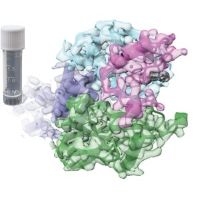Specification
| Description | Recombinant protein from the full-length sequence of Homo sapiens hydroxysteroid 17-beta dehydrogenase 11 (HSD17B11) (NM_016245). |
| Organism | Homo sapiens (Human) |
| Expression Host | Human Cells |
| Tag Info | His or DYKDDDDK. Please contact us if you need further information or require specific designed tag. |
| Purity | Greater than 90% by SDS-PAGE gel |
| Uniprot ID | Q8NBQ5 |
| Entry Name | DHB11_HUMAN |
| Gene Names | HSD17B11 DHRS8 PAN1B SDR16C2 PSEC0029 UNQ207/PRO233 |
| Alternative Gene Names | DHRS8 PAN1B SDR16C2 |
| Alternative Protein Names | Estradiol 17-beta-dehydrogenase 11 (EC 1.1.1.62) (17-beta-hydroxysteroid dehydrogenase 11) (17-beta-HSD 11) (17bHSD11) (17betaHSD11) (17-beta-hydroxysteroid dehydrogenase XI) (17-beta-HSD XI) (17betaHSDXI) (Cutaneous T-cell lymphoma-associated antigen HD-CL-03) (CTCL-associated antigen HD-CL-03) (Dehydrogenase/reductase SDR family member 8) (Retinal short-chain dehydrogenase/reductase 2) (retSDR2) (Short chain dehydrogenase/reductase family 16C member 2) |
| Application | Antigens, Western, ELISA and other in vitro binding or in vivo functional assays, and protein-protein interaction studies; For research & development use only! |
| Buffer | Purified protein formulated in a sterile solution of PBS buffer, pH7.2, without any preservatives |
| Endotoxin | Endotoxin level is < 0.1 ng/µg of protein (<1EU /µg) |
| Length | 300 |
| Molecular Weight(Da) | 32936 |
| Protein Sequence | (The sequence of expressed protein may have some variation from the sequence shown below. Please contact us for the exact sequence.) MKFLLDILLLLPLLIVCSLESFVKLFIPKRRKSVTGEIVLITGAGHGIGRLTAYEFAKLKSKLVLWDINKHGLEETAAKCKGLGAKVHTFVVDCSNREDIYSSAKKVKAEIGDVSILVNNAGVVYTSDLFATQDPQIEKTFEVNVLAHFWTTKAFLPAMTKNNHGHIVTVASAAGHVSVPFLLAYCSSKFAAVGFHKTLTDELAALQITGVKTTCLCPNFVNTGFIKNPSTSLGPTLEPEEVVNRLMHGILTEQKMIFIPSSIAFLTTLERILPERFLAVLKQKISVKFDAVIGYKMKAQ |
Background
| Function | FUNCTION: Can convert androstan-3-alpha,17-beta-diol (3-alpha-diol) to androsterone in vitro, suggesting that it may participate in androgen metabolism during steroidogenesis. May act by metabolizing compounds that stimulate steroid synthesis and/or by generating metabolites that inhibit it. Has no activity toward DHEA (dehydroepiandrosterone), or A-dione (4-androste-3,17-dione), and only a slight activity toward testosterone to A-dione. Tumor-associated antigen in cutaneous T-cell lymphoma. |
| Pathway | |
| Protein Families | Short-chain dehydrogenases/reductases (SDR) family, 17-beta-HSD 3 subfamily |
| Tissue Specificity | Present at high level in steroidogenic cells such as syncytiotrophoblasts, sebaceous gland, Leydig cells, and granulosa cells of the dominant follicle and corpus luteum. In lung, it is detected in the ciliated epithelium and in acini of adult trachea, in bronchioles, but not in alveoli. In the eye, it is detected in the nonpigmented epithelium of the ciliary body and, at lower level, in the inner nuclear layer of the retina (at protein level). Widely expressed. Highly expressed in retina, pancreas, kidney, liver, lung, adrenal, small intestine, ovary and heart. {ECO:0000269|PubMed:10800688, ECO:0000269|PubMed:11165019, ECO:0000269|PubMed:12697717, ECO:0000269|PubMed:9888557}. |
QC Data
| Note | Please contact us for QC Data |
| Product Image (Reference Only) |  |

